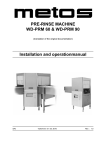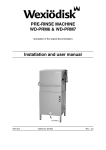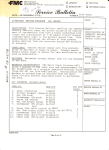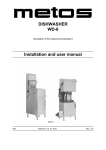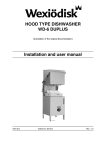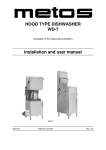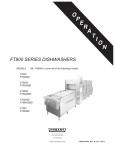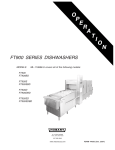Download Pre-rinse machine WD-PRM 6 & WD-PRM 7 Installation and
Transcript
Pre-rinse machine WD-PRM 6 & WD-PRM 7 (translation of the original documentation) Installation and user manual S/N: Valid from: 01. 01. 2011 Rev.: 2.0 WD-PRM 6 & WD-PRM 7 Rev. 2.0 Dear Customer, Congratulations on deciding to choose a Metos appliance for your kitchen activities. You made an excellent choice. We will do our best to make you a satisfied Metos customer like thousands of customers we have around the world. Please read this manual carefully. You will learn correct, safe and efficient working methods in order to get the best possible benefit from the appliance. The instructions and hints in this manual will give you a quick and easy start, and you will soon note how nice it is to use the Metos equipment. All rights are reserved for technical changes. You will find the main technical data on the rating plate fixed to the equipment. When you need service or technical help, please let us know the serial number shown on the rating plate. This will make it easier to provide you with correct service. For your convenience, space is provided below for you to record your local Metos service contact information. METOS TEAM Metos service phone number:................................................................................ Contact person:...................................................................................................... WD-PRM 6 & WD-PRM 7 Rev. 1. General .............................................................................................. 1 1.1 Symbols used in this manual ........................................................................... 1.2 Symbols on the dishwasher ............................................................................. 1.2.1 Machine marking ...................................................................................... 1.3 Checking agreement between the appliance and the manual ......................... 1 2 2 2 2. Safety instructions ........................................................................... 3 2.1 General ............................................................................................................ 2.2 Transport .......................................................................................................... 2.3 Installation ........................................................................................................ 2.4 Operation ......................................................................................................... 2.4.1 Risk of crushing ........................................................................................ 3 3 3 4 4 2.5 Cleaning ........................................................................................................... 2.5.1 Cleaning the machine ............................................................................... 2.5.2 The outside of the machine ...................................................................... 2.5.3 Cleaning with high-pressure washing ....................................................... 2.5.4 Cleaning the floor ...................................................................................... 2.6 Repairing and servicing the dishwasher .......................................................... 2.7 Recycling the machine ..................................................................................... 4 4 4 4 4 5 5 3. Installation ........................................................................................ 6 3.1 General ............................................................................................................ 6 3.2 Requirements for installation on site ................................................................ 6 3.2.1 Lighting ..................................................................................................... 6 3.2.2 Ventilation ................................................................................................. 6 3.2.3 Drains ....................................................................................................... 6 3.2.4 Service space ........................................................................................... 7 3.3 Transport and storage ...................................................................................... 7 3.3.1 Unpacking ................................................................................................. 7 3.3.2 Recycling the packaging ........................................................................... 7 3.4 Installation ........................................................................................................ 8 3.4.1 Positioning the machine ............................................................................ 8 3.4.2 Connections .............................................................................................. 9 3.4.3 Installation of auxiliary equipment ........................................................... 13 3.5 Trial run .......................................................................................................... 14 3.5.1 Start-up schedule .................................................................................... 14 3.6 Technical documentation ............................................................................... 15 WD-PRM 6 & WD-PRM 7 Rev. 4. Directions for use ........................................................................... 16 4.1 Preparations ................................................................................................... 4.1.1 The machine’s design, WD-PRM 6/7 ...................................................... 4.1.2 Preparations before filling ....................................................................... 4.1.3 Filling the machine .................................................................................. 4.2 Use ................................................................................................................. 4.2.1 General ................................................................................................... 4.2.2 Pre-rinse. Machine with manual hood lift ................................................ 4.2.3 Pre-rinse. Machine with automatic hood lift (extra equipment) .............. 4.2.4 Stopping the machine during operation .................................................. 4.3 After use – Cleaning ...................................................................................... 4.3.1 Emptying ................................................................................................. 4.3.2 Cleaning .................................................................................................. 17 17 18 18 18 18 18 18 19 19 19 19 5. Technical information .................................................................... 21 WD-PRM 6 & WD-PRM 7 Rev. 2.0 General 1. General Read the instructions in this manual carefully as they contain important information regarding correct, effective and safe installation, use and service of the dishwasher. The WD-PRM 6/7 can only replace manual rinsing of items. In the future, the items must still be washed and rinsed out in a dishwasher. Keep this manual in a safe place for eventual use by other operators of the dishwasher. The electronics in the machine are RoHS compatible. 1.1 Symbols used in this manual This symbol warns of situations where a safety risk may arise. The instructions given should be followed in order to prevent injury. This symbol on a machine part warns of electrical equipment. The machine is sensitive to electrostatic discharge (ESD), which is why a static electricity bracelet must be used when handling the electronics. This symbol explains the right way to perform a task in order to prevent poor results, damage to the dishwasher or hazardous situations. This symbol gives recommendations and hints that help to get the best performance from the machine. This symbol explains the importance of careful and regular cleaning of the machine to meet hygiene requirements. 1 WD-PRM 6 & WD-PRM 7 Rev. 2.0 General 1.2 Symbols on the dishwasher This symbol on a machine part warns of electrical equipment. The part may only be removed by a qualified electrician or trained personnel. The machine is sensitive to electrostatic discharge (ESD), which is why a static electricity bracelet must be used when handling the electronics. 1.2.1 Machine marking The machine has two rating plates, one of which is placed on the right side of the machine and the other in the electrical cabinet. The technical information on the plates is also included on the machine’s wiring diagram. The various rating fields show: Wexiödisk AB Type 1 No M 3 2 5 V 6 9 kW IP 4 7 Hz 8 10 kW A 11 kW Mårdvägen 4, S-352 45 V ÄXJÖ SWEDEN 1. 2. 3. 4. 5. 6. 7. 8. 9. 10. 11. 1.3 marks_07 Machine type Machine number Year of manufacture Enclosure class Voltage Number of phases with or without zero Frequency Main fuse Motor output Electrical heating output Max. output Checking agreement between the appliance and the manual Check the type description on the rating plate agrees with the type description on the front of the manual. If manuals are missing, it is possible to order new ones from the manufacturer or the local representative. When ordering new manuals, it is important to quote the machine number found on the rating plates. 2 WD-PRM 6 & WD-PRM 7 Rev. 2.0 Safety instructions 2. Safety instructions 2.1 General The machine is CE marked, which means that the machine complies with the requirements of the EU machinery directive with regards to product safety. Product safety means the machine has a design which prevents personal injury or damage to property. Modification to the equipment without the approval of the manufacturer invalidates the manufacturer’s product liability. To further improve safety during installation, operation and service, the operator and personnel responsible for installation and servicing of the machine should read through the safety instructions carefully. Switch off the appliance immediately in the event of failure or malfunction. Only trained technicians may service the machine. Regular checks, as mentioned in the manual, should be carried out as per the instructions. The machine should be serviced by a person authorised to do so by the manufacturer. Use original spare parts. Contact an authorised service company to draw up a programme for preventative care. Dangerous situations may arise if the above is not followed. Before using the machine, ensure that personnel are given the requisite training in handling and care of the machine. 2.2 Transport Handle the machine with care during unloading and transport to avoid tipping. Never lift or move the machine without the wooden packaging supporting the stand. 2.3 Installation The electrical cabinet may only be opened by a qualified electrician or trained personnel. The machine is sensitive to electrostatic discharge (ESD), which is why a static electricity bracelet must be used when handling the electronics. Make sure that the mains voltage is the same as that indicated on the machine’s rating plate. The machine should be connected to a lockable main switch. 3 WD-PRM 6 & WD-PRM 7 Rev. 2.0 Safety instructions 2.4 Operation 2.4.1 Risk of crushing If the machine has an automatic hood lift, take care when the lid is closing that your fingers or arms do not become trapped. 2.5 Cleaning 2.5.1 Cleaning the machine The temperature of the water in the tank is approx. 40°C and contains detergent. Be careful when emptying and cleaning the machine. Use protective gloves. 2.5.2 The outside of the machine Pressure washers and hoses must not be used to wash the outside of the machine. Water can penetrate into the electrical cabinet and the control panel and damage the equipment, which may affect the safety of the machine. 2.5.3 Cleaning with high-pressure washing The machine must not be cleaned with a pressure washer, either inside or out. In order to satisfy current requirements, electrical components of approved enclosure classes are used. There is no enclosure class capable of withstanding high pressure. 2.5.4 Cleaning the floor When cleaning floors using high-pressure equipment, water can splash up under the machine and damage the components. These have not been designed to withstand rinsing with water. Never use high pressure washes on the floor less than 1 meter from the dishwasher without the special protecting covers available to prevent splashes. Problems with splashing can also occur when using ordinary water hoses. 4 WD-PRM 6 & WD-PRM 7 Rev. 2.0 Safety instructions 2.6 Repairing and servicing the dishwasher Turn off the power before working on the machine. Check the following: • • • • Has the appliance been used according to the instructions? Are all removable parts present? Is the main switch in the ON position? Are the fuses in the electrical cabinet complete? Ask service personnel to check the fuses. If nothing else helps, ask authorised service personnel to check the machine. 2.7 Recycling the machine Recycling of the appliance when its economical lifetime has been reached must be carried out in accordance with current rules and regulations. Contact professional personnel specialising in recycling. 5 WD-PRM 6 & WD-PRM 7 Rev. 2.0 Installation 3. Installation 3.1 General The machine must only be installed by authorised personnel. Read these instructions through carefully as they contain important information regarding correct installation. The WD-PRM 6/7 cannot be combined with a WD 6/7 that is fitted with a heat recovery by the drain water. The dishwasher connected to the WD-PRM 6/7 should have software version 4.7 or later. Where the dishwasher has an earlier software version, it should be updated. The instructions should be used together with the machine’s wiring diagram. The machine is CE marked. The CE mark is only valid for the machines with the original design. If the machine is damaged as a result of the instructions not being followed, the supplier guarantee and product liability is invalidated. 3.2 Requirements for installation on site 3.2.1 Lighting In order to ensure the best possible working conditions during installation, operation, service and maintenance, make sure that the machine is installed in a welllit room. 3.2.2 Ventilation The machine generates heat and steam when in operation. For a good working environment, a certain air change rate is required in the washing room. The ventilation requirements for the room are calculated as per applicable standards. 3.2.3 Drains There must be a floor drain for the machine's waste water. The floor drain capacity can be found in the TECHNICAL SPECIFICATIONS. 6 WD-PRM 6 & WD-PRM 7 Rev. 2.0 Installation 3.2.4 Service space A 1-metre free space should be allowed in front of the machine for service purposes. 3.3 Transport and storage Always transport the machine in an upright position. Take care during transport, as there is a risk of tipping. NB! The machine must not be transported without a pallet or other support. The machine may be damaged otherwise. When transporting the machine without the ordinary wooden pallet, always check that none of the machine components can be damaged. A PRM_04 A=Wooden pallet If the machine is not being installed straight away, it must be stored frost-free in premises with dry air. 3.3.1 Unpacking Remove the packing material. Inspect the machine for any transport damage. Check that all units have been delivered by comparing with the delivery note. 3.3.2 Recycling the packaging Packaging must be sent for destruction or recycling in accordance with local regulations. 7 WD-PRM 6 & WD-PRM 7 Rev. 2.0 Installation 3.4 Installation 50 The level pipe in the connected dishwasher must be removed and replaced by a bottom filter. WD-6C WD-6 WD-7 WD-PRM 6 WD-PRM 7 WD-6C WD-6 WD-7 WD-PRM 6 WD-PRM 7 WD-6C WD-6 WD-7 WD-PRM 6 WD-PRM 7 WD-6C WD-6 WD-7 WD-PRM 6 WD-PRM 7 130 300 A WD-6C WD-6 WD-7 WD-PRM 6 WD-PRM 7 WD-6C WD-6 WD-7 WD-PRM 6 WD-PRM 7 303082 300 50 A=With or without cupboard (option) 3.4.1 Positioning the machine Put the machine in position and check that it is horizontal using a spirit level. Place the spirit level on the join between the machine tank and the hood. Once the machine has been filled with water, check that it is level. Adjust the height using the machine’s legs. The machine even can be furnished with extensions leg (35 mm). 8 WD-PRM 6 & WD-PRM 7 Rev. 2.0 Installation 3.4.2 Connections Connections WD-PRM 6/7 1. 2. 3. 4. 5. 6. Bleed screw for the lifting cylinder (option) Power connection Water connection in the bottom of the washing tank for incoming water from the hood dishwasher. Drain connection in the bottom of the washing tank. Hot water connection (option) Drain lever Electrical connection This symbol on a machine part warns of electrical equipment. The part may only be removed by a qualified electrician. The machine is sensitive to electrostatic discharge (ESD), which is why a static electricity bracelet must be used when handling the electronics. The machine should be connected to a lockable main switch. This should be placed on the wall, well protected against water and steam emissions. Information for and on electrical connection is shown on the machine’s wiring diagram. This is placed in the plastic pocket on the inside of the electrical cabinet door. The machine is supplied with the electrical cable connected (2). 9 WD-PRM 6 & WD-PRM 7 Rev. 2.0 Installation Water connection The machine fills with water (3) via the hood dishwasher that the WD-PRM 6/7 is connected to. If the machine has a water-powered automatic hood, the water is connected to (5). The required water flow and pressure can be found in the TECHNICALSPECIFIKATIONS. Bleeding the hood lifting cylinder, with a pump connection (option) • • • • Open the bleed screw (1). Press the 0/1 button. Open the hood. Close the bleed screw (1) when water comes out of the hole on the screw. Bleeding the hood lifting cylinder, with a water connection (option) Open the bleed screw (1). Press the 0/1 button and open the water stopcock slightly until a small amount of water flows out of the bleed screw (1). Let the water run until no air bubbles are left in the hose. Close the bleed screw (1) and open the stopcock fully. Drain connection - Interconnection with dishwasher The drain connected to (3) should use 50 mm metal pipes that tolerate mechanical collision in those cases where there is a risk of collision; otherwise it should use 50 mm PV pipes. The drain is run to a floor drain, where it must end above the water level. The capacity of the floor drain must be 3 litres/second. It is important to properly secure the waste pipes of the WD-PRM 6/7 and of the dishwasher. 10 WD-PRM 6 & WD-PRM 7 Rev. 2.0 Installation Drain connection. Feed from right to left Water and drain connections seen from above. The hood dishwasher placed to the left of the WD-PRM 6/7. • • • • • • A=Water connection in the bottom of the hood dishwasher's washing tank. The connection must be fitted with a bottom filter. (NOTE: No level pipe) B=Connecting pipe. Cut to a suitable length. C=Connection for connecting pipe. D=Water connection in the bottom of the WD-PRM 6/7's washing tank. The connection must be fitted with a bottom filter. (NOTE: No level pipe) E=Drain connection in the bottom of the WD-PRM 6/7's washing tank. (Location of level pipe) F=Connection for waste pipe between machine and floor drain. 11 WD-PRM 6 & WD-PRM 7 Rev. 2.0 Installation Drain connection. Feed from left to right Water and drain connections seen from above. The hood dishwasher placed to the right of the WD-PRM 6/7. • • • • • • • A=Water connection in the bottom of the hood dishwasher's washing tank. The connection must be fitted with a bottom filter. (NOTE: No level pipe) B=Connecting pipe. Cut to a suitable length. C=Connection for connecting pipe. D=Water connection in the bottom of the WD-PRM 6/7's washing tank. The connection must be fitted with a bottom filter. (NOTE: No level pipe) E=Drain connection in the bottom of the WD-PRM 6/7's washing tank. (Location of level pipe) F=Connection for waste pipe between machine and floor drain. G=Water connection in the bottom of the hood dishwasher's washing tank. The connection must be fitted with a bottom filter. (NOTE: No level pipe) 12 WD-PRM 6 & WD-PRM 7 Rev. 2.0 Installation 3.4.3 Installation of auxiliary equipment Once the machine is in place and adjusted horizontally and vertically, any peripheries can be mounted. NB! When connecting sinks and conveyors, no holes must be drilled in the machine. The sinks are hooked firmly on to the top edge of the tank. Use a spirit level to check that the sinks are horizontal and adjust the height, if necessary. WD-PRM 6/7 A=Distance between the machines 13 WD-PRM 6 & WD-PRM 7 Rev. 2.0 Installation 3.5 Trial run Prepare the machine for a trial run using the INSTRUCTIONS FOR USE. This describes the measures that must be taken to make the machine ready for operation. 3.5.1 Start-up schedule This should be completed and acknowledged by the customer on start-up. Machine type: Machine number: Installation date: Customer: Postal address: Telephone: Contact person: Dealer: Telephone: Contact person: Installation company: Telephone: Contact person: Service company: Telephone: Detergent supplier: Telephone: End user’s signature: Name in block capitals: Read the contents of the installation and user manuals carefully. Then check off as follows: 14 WD-PRM 6 & WD-PRM 7 Rev. 2.0 Installation 1. Check: • • • • Water and drain connections That the machine is evenly balanced Filters and level pipe are in place The drain lever is closed 2. Filling the machine: • • • Note: The hood dishwasher that is connected must be started Press the 0/1 button Fill the machine with water as per the INSTRUCTIONS FOR USE 3. Start the machine: • Check the pump’s direction of rotation NOTE! If the direction of rotation is wrong, the phase must be inverted on the lockable main switch. 4. Run a number of baskets complete with loads and check that: • • There are no water leaks The hood switch functions 5. Final check: Empty the machine and turn off the power using the main switch. • • • Re-tighten all connections on contactors and any circuit breakers Set all circuit breakers to ON position Display the maintenance instructions supplied with the machine. 6. Train dishwashing staff 3.6 Technical documentation For correct use and servicing, it is essential that the documentation accompanying the machine is made available to personnel who will be using the machine. The installation and user manual, which describes handling and care among other things, should be stored near the machine. If the service manual accompanies the delivery, this should be passed on to the responsible service technician later on. If the spare partsmanual accompanies the delivery, this should be passed on to the responsible service technician later on. 15 WD-PRM 6 & WD-PRM 7 Rev. 2.0 Directions for use 4. Directions for use All staff using the machine must be given training in how the machine works by the person responsible for staff safety. The machine should not be used by anyone suffering from a physical or mental illness. Children should be supervised to ensure that they do not play with the machine. The machine is intended to be used for the rinsing of items used for the preparation and serving of food, as well as various types of items for the storage of food. The items must be washed and rinsed in a dishwasher. 16 WD-PRM 6 & WD-PRM 7 Rev. 2.0 Directions for use 4.1 Preparations 4.1.1 The machine’s design, WD-PRM 6/7 1. 2. 3. 4. 5. 6. 7. 8. 9. 10. 11. “Autostart” (if the machine has this option, the hood is closed automatically when a basket is loaded in the machine.) (option) Tank filter Level pipe Rubber sleeve Pump filter Bottom filter Wash arm Rinse nozzle Button to switch the power on or off. Lit when the tank is filled. Button for opening/closing the hood. (On machines with an automatic hood lift.) (option) Drain lever 17 WD-PRM 6 & WD-PRM 7 Rev. 2.0 Directions for use 4.1.2 Preparations before filling Numbers in brackets refer to pictures in the chapter "The machine’s design". Check: • that the drain lever (11) has been turned to the right as far as it will go, and all removable components are clean and that there is no dirt in the washer arms (7). Assemble: • level pipe (3) and filter (2). 4.1.3 Filling the machine Numbers in brackets refer to pictures in the chapter "The machine’s design". NOTE: The hood dishwasher must be started. When the hood dishwasher is started, both the machines are filled with water at the same time. • 4.2 Press the 0/1 button (9) to switch on the power. The lamp in the button lights up when the machine is filled. Use 4.2.1 General During operation the dishwasher’s tank fills automatically. For optimum results it is essential to keep the filters (2) clean. Remove them and rinse it out regularly. 4.2.2 Pre-rinse. Machine with manual hood lift Push in the basket and close the hood. The pre-rinse willstart automatically.After approx. 30 seconds the pre-rinse is complete. Open the hoodand push the basket into the hood dishwasher for wash and finalrinse. 4.2.3 Pre-rinse. Machine with automatic hood lift (extra equipment) Push in the basket and close the hood by pressing the button(10). The prerinse will start.If the machine is fitted with "Autostart" (1), the hood is closedautomatically when a basket is loaded. The pre-rinse will start.(extra equipment)After approx. 30 seconds the pre-rinse is complete and the hoodopens automatically. Push the basket into the hood dishwasher forwash and final rinse. 18 WD-PRM 6 & WD-PRM 7 Rev. 2.0 Directions for use 4.2.4 Stopping the machine during operation If the machine needs to be stopped when it is in operation, use the buttons on the control panel. Press the 0/1 button (9) to turn off the power. Restart: Press the 0/1 button (9). 4.3 After use – Cleaning 4.3.1 Emptying Numbers in brackets refer to pictures in the chapter “The machine’s design”. • • Press the 0/1 button (9). Empty the tank by turning the drain handle (11) to the left. 4.3.2 Cleaning Daily internal cleaning Clean the filter (2,6). Check the washer arms (7) nozzles (8); if necessary, remove and clean. Rinse out all of the machine’s inside surfaces, and clean the tank. Daily external cleaning Wipe the outside of the machine with a soft, damp cloth. Weekly cleaning (or as required) Weekly cleaning should be carried out more thoroughly than daily cleaning. In addition to the measures for daily cleaning, clean the machine as follows: • • Washer arms (7): brush the interior. Also clean the washer arm nozzles. Decalcify the machine when necessary. Cleaning brush w721,0301 19 WD-PRM 6 & WD-PRM 7 Rev. 2.0 Directions for use Incorrect cleaning methods An incorrect cleaning method may damage the machine. The following therefore applies: • • Do NOT use steel wool as it will corrode the machine. High-pressure cleaning can damage the machine and must NOT be used for cleaning purposes. Never use a pressure washer on the floor less than 1 metre from the dishwasher without the special protective covers available to prevent splashes. The supplier cannot be held responsible for any faults caused by the use of pressure washers on the machine and such action will void the guarantee. Steel wool and pressure washers must not be used for cleaning. There is a risk of splashing even if the floor is hosed down. If detergent is used, it must not contain abrasives. Detergents containing abrasives will damage the stainless steel panels. The machine must not be hosed down externally. Water can enter the control panel and damage electrical equipment. Operational disturbances When you contact the service personnel, you will need to answer the following questions about the machine: • • • • machine type and model machine serial number and installation date short description of the fault/problem what happened/was being done immediately before the fault occurred 20 WD-PRM 6 & WD-PRM 7 Rev. 2.0 Technical information 5. Technical information The manufacturer reserves the right to make changes to this technical data. TECHNICAL DATA Pump motor (kW) Tank volume (l) Weight, machine in operation (kg) (WD-PRM 6) Weight, machine in operation (kg) (WD-PRM 7) Enclosure class (IP) 0,9 45 130 150 45 CAPACITY AND OPERATING DATA Total pre-rinse time (min) Max. capacity, baskets/h (pcs/h) Sound level (1m from machine) (dB (A)) 0,5 120 64 * Measured 1 metre from the side of the machine. CONNECTION, MACHINE Total connected power (kW) Main fuse 400V 3N~ (A) * Max. connection area 400V 3N~ (L1-L3, N, PE) Cu (mm²) ** 0,9 10 2,5 * Other connection voltages on request. ** 2 metre-long cable included WATER, DRAIN AND VENTILATION CONNECTIONS Drain connection, PP pipe (ø mm) Water capacity hood lift, pressure (kPa) * Water capacity hood lift, flow (litres/minute) * Floor drain, capacity (l/min) Ventilation of machine (m³/h) 50 300 2 3 200 * Extra equipment At a lower pressure/flow, the machine should be fitted with a booster pump SIZE AND WEIGHT FOR TRANSPORT Size (LxWxH) (mm) * (WD-PRM 6) Size (LxWxH) (mm) * (WD-PRM 7) Weight (kg) * (WD-PRM 6) Weight (kg) * (WD-PRM 7) 765x710x1560 765x805x1650 100 105 * Including packaging. 21


























